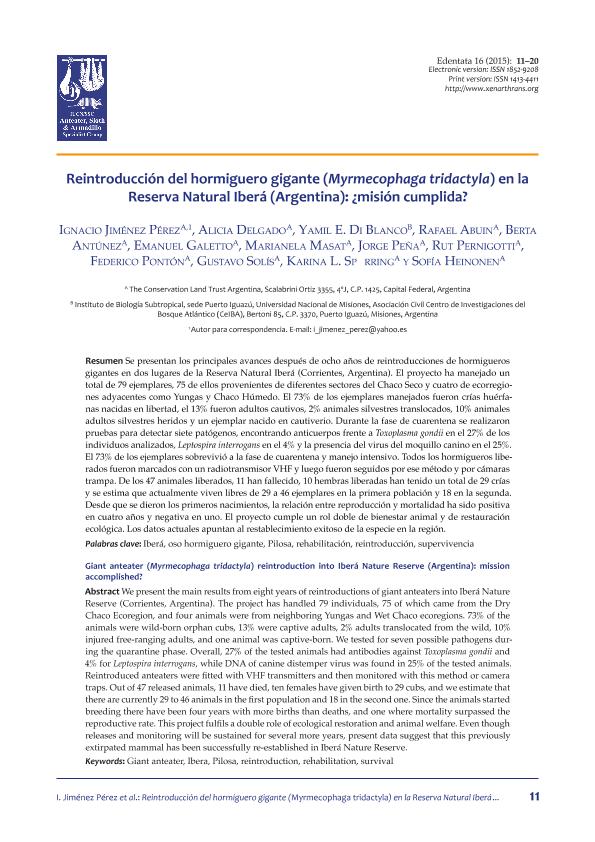Mostrar el registro sencillo del ítem
dc.contributor.author
Jiménez Pérez, Ignacio
dc.contributor.author
Delgado, Alicia
dc.contributor.author
Di Blanco, Yamil Edgardo

dc.contributor.author
Abuin, Rafael
dc.contributor.author
Antúnez, Berta
dc.contributor.author
Galetto, Emanuel
dc.contributor.author
Masat, Marianella
dc.contributor.author
Peña, Jorge
dc.contributor.author
Pernigotti, Rut
dc.contributor.author
Pontón, Federico
dc.contributor.author
Solís, Gustavo
dc.contributor.author
Karina Spørring
dc.contributor.author
Heinonen, Sofía
dc.date.available
2019-07-23T21:02:29Z
dc.date.issued
2015-09
dc.identifier.citation
Jiménez Pérez, Ignacio; Delgado, Alicia; Di Blanco, Yamil Edgardo; Abuin, Rafael; Antúnez, Berta; et al.; Reintroducción del hormiguero gigante (Myrmecophaga tridactyla) en la Reserva Natural Iberá (Argentina): ¿misión cumplida?; Anteater, Sloth and Armadillo Specialist Group; Edentata; 16; 9-2015; 11-20
dc.identifier.issn
1413-4411
dc.identifier.uri
http://hdl.handle.net/11336/80095
dc.description.abstract
Se presentan los principales avances después de ocho años de reintroducciones de hormigueros gigantes en dos lugares de la Reserva Natural Iberá (Corrientes, Argentina). El proyecto ha manejado un total de 79 ejemplares, 75 de ellos provenientes de diferentes sectores del Chaco Seco y cuatro de ecorregionesadyacentes como Yungas y Chaco Húmedo. El 73% de los ejemplares manejados fueroncrías huérfanas nacidas en libertad, el 13% fueron adultos cautivos, 2% animales silvestres translocados, 10% animales adultos silvestres heridos y un ejemplar nacido en cautiverio. Durante la fase de cuarentena se realizaron pruebas para detectar siete patógenos, encontrando anticuerpos frente a Toxoplasma gondii en el 27% de los individuos analizados, Leptospira interrogans en el 4% y la presencia del virus del moquillo canino en el 25%. El 73% de los ejemplares sobrevivió a la fase de cuarentena y manejo intensivo. Todos los hormiguerosliberados fueron marcados con un radiotransmisor VHF y luego fueron seguidos por ese método y por cámaras trampa. De los 47 animales liberados, 11 han fallecido, 10 hembras liberadas han tenido un total de 29 crías y se estima que actualmente viven libres de 29 a 46 ejemplares en la primera población y 18 en la segunda.Desde que se dieron los primeros nacimientos, la relación entre reproducción ymortalidad ha sido positiva en cuatro años y negativa en uno. El proyecto cumple un rol doble de bienestar animal y de restauración ecológica. Los datos actuales apuntan al restablecimiento exitoso de la especie en la región.
dc.description.abstract
We present the main results from eight years of reintroductions of giant anteaters into Iberá Nature Reserve (Corrientes, Argentina). The project has handled 79 individuals, 75 of which came from the Dry Chaco Ecoregion, and four animals were from neighboring Yungas and Wet Chaco ecoregions. 73% of the animals were wild-born orphan cubs, 13% were captive adults, 2% adults translocated from the wild, 10% injured free-ranging adults, and one animal was captive-born. We tested for seven possible pathogens during the quarantine phase. Overall, 27% of the tested animals had antibodies against Toxoplasma gondii and 4% for Leptospira interrogans, while DNA of canine distemper virus was found in 25% of the tested animals. Reintroduced anteaters were fitted with VHF transmitters and then monitored with this method or camera traps. Out of 47 released animals, 11 have died, ten females have given birth to 29 cubs, and we estimate that there are currently 29 to 46 animals in the first population and 18 in the second one. Since the animals started breeding there have been four years with more births than deaths, and one where mortality surpassed the reproductive rate. This project fulfils a double role of ecological restoration and animal welfare. Even though releases and monitoring will be sustained for several more years, present data suggest that this previously extirpated mammal has been successfully re-established in Iberá Nature Reserve.
dc.format
application/pdf
dc.language.iso
spa
dc.publisher
Anteater, Sloth and Armadillo Specialist Group
dc.rights
info:eu-repo/semantics/openAccess
dc.rights.uri
https://creativecommons.org/licenses/by-nc-sa/2.5/ar/
dc.subject
Iberá
dc.subject
Oso Hormiguero Gigante
dc.subject
Pilosa
dc.subject
Rehabilitación
dc.subject
Reintroducción
dc.subject
Supervivencia
dc.subject.classification
Otras Ciencias Biológicas

dc.subject.classification
Ciencias Biológicas

dc.subject.classification
CIENCIAS NATURALES Y EXACTAS

dc.title
Reintroducción del hormiguero gigante (Myrmecophaga tridactyla) en la Reserva Natural Iberá (Argentina): ¿misión cumplida?
dc.title
Giant anteater (Myrmecophaga tridactyla) reintroduction into Iberá Nature Reserve (Argentina): mission accomplished?
dc.type
info:eu-repo/semantics/article
dc.type
info:ar-repo/semantics/artículo
dc.type
info:eu-repo/semantics/publishedVersion
dc.date.updated
2019-05-10T14:10:48Z
dc.journal.number
16
dc.journal.pagination
11-20
dc.journal.pais
Argentina

dc.description.fil
Fil: Jiménez Pérez, Ignacio. The Conservation Land Trust; Estados Unidos
dc.description.fil
Fil: Delgado, Alicia. The Conservation Land Trust; Estados Unidos
dc.description.fil
Fil: Di Blanco, Yamil Edgardo. Consejo Nacional de Investigaciones Científicas y Técnicas. Centro Científico Tecnológico Conicet - Nordeste. Instituto de Biología Subtropical. Instituto de Biología Subtropical - Nodo Puerto Iguazú | Universidad Nacional de Misiones. Instituto de Biología Subtropical. Instituto de Biología Subtropical - Nodo Puerto Iguazú; Argentina. Centro de Investigaciones del Bosque Atlántico; Argentina
dc.description.fil
Fil: Abuin, Rafael. The Conservation Land Trust; Estados Unidos
dc.description.fil
Fil: Antúnez, Berta. The Conservation Land Trust; Estados Unidos
dc.description.fil
Fil: Galetto, Emanuel. The Conservation Land Trust; Estados Unidos
dc.description.fil
Fil: Masat, Marianella. The Conservation Land Trust; Estados Unidos
dc.description.fil
Fil: Peña, Jorge. The Conservation Land Trust; Estados Unidos
dc.description.fil
Fil: Pernigotti, Rut. The Conservation Land Trust; Estados Unidos
dc.description.fil
Fil: Pontón, Federico. The Conservation Land Trust; Estados Unidos
dc.description.fil
Fil: Solís, Gustavo. The Conservation Land Trust; Estados Unidos
dc.description.fil
Fil: Karina Spørring. The Conservation Land Trust; Estados Unidos
dc.description.fil
Fil: Heinonen, Sofía. The Conservation Land Trust; Estados Unidos
dc.journal.title
Edentata

dc.relation.alternativeid
info:eu-repo/semantics/altIdentifier/url/http://www.xenarthrans.org/resources/newsletter/Jimenez-Perez%20et%20al_in%20press_corrected.pdf
Archivos asociados
